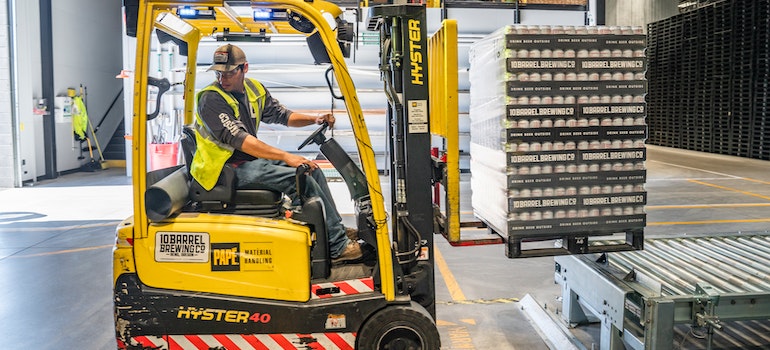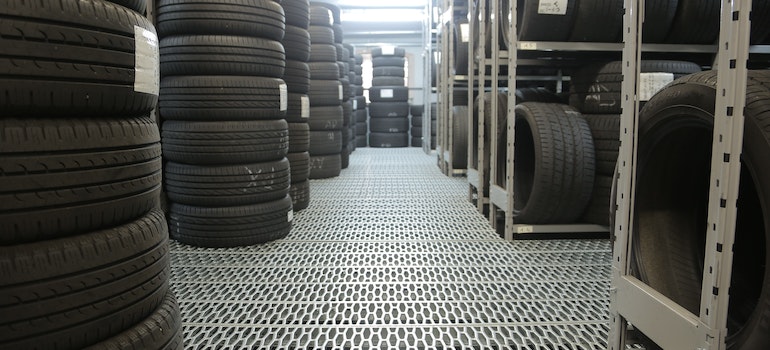Heavy equipment storage tips
Heavy equipment is a vital part of many industries, and it is essential to ensure that it is well-maintained and protected when not in use. Proper storage is critical to ensuring that heavy equipment remains in good condition and is ready for use when needed. Being in the moving industry for many years, Hansen Bros. Moving and Storage Seattle, WA know a lot about using heavy equipment and correctly storing it. With our extensive knowledge and expertise, we present you with valuable advice on heavy equipment storage. Learn if your industry can benefit from it, how to prepare your machinery for storage, and how to maintain your heavy equipment!
Who can benefit from using heavy equipment storage?
Heavy equipment is used in a wide range of industries, including construction, mining, agriculture, forestry, and transportation. These industries rely heavily on the use of large, complex machines to complete tasks such as excavation, hauling, drilling, and cutting. Here are some of the industries which use heavy equipment regularly:
- Construction companies use heavy equipment such as bulldozers, excavators, and cranes to build new structures, including buildings, roads, and bridges.
- Mining companies use heavy equipment such as drills and loaders to extract minerals from the earth.
- Agriculture and forestry companies use tractors, harvesters, and other equipment to plant and harvest crops or clear land for timber.
- Transportation companies, including railroads and shipping companies, use heavy equipment such as locomotives and cranes to move and load cargo.
- Waste management companies use garbage trucks and compactors to collect and dispose of trash.
Another industry that uses heavy equipment for transportation is the moving industry. When you arrange the help of moving services Seattle businesses use, know that movers utilize a variety of heavy equipment to make relocation safe and fast.

Anyone who owns or operates heavy equipment may need to store it when it is not in use. This includes companies that use heavy equipment regularly as part of their business operations, as well as individuals who may use heavy equipment for personal projects or hobbies. Proper storage is important for protecting the equipment from damage and ensuring that it remains functional and safe for use.
How to prepare your heavy equipment for storage
There are several key steps that should be taken before heavy equipment movers take your equipment into storage.
Choose the right heavy equipment storage location
The first step is to choose the right storage location. The storage location should be dry, well-ventilated, and protected from the elements. If possible, store heavy equipment in a covered area such as a garage or storage unit. If a covered area is not available, consider using a weatherproof tarp to protect the equipment from rain, snow, and other elements. Knowing how unpredictable and unpleasant weather in Seattle can be, look into reliable Seattle storage in order to keep your equipment safe and undamaged.
Prepare the equipment for storage
Before storing heavy equipment, it is important to prepare it for storage. This involves cleaning the equipment thoroughly. Dirt, debris, and other contaminants can cause damage to the equipment over time, especially if left on for an extended period. A thorough cleaning will also help prevent the growth of rust and other corrosive substances that can damage the equipment. Remove any attachments or accessories and store them separately.
If you plan on storing your heavy equipment out of town, it’s important to keep your equipment safe during transport. For bigger parts, you should look into reliable moving companies that have larger trucks available. For moving smaller parts, your best option would be to use moving boxes Seattle business owners choose for transporting their supplies. This will keep your equipment safe before putting it into storage.

Heavy equipment requires regular maintenance to ensure that it remains in good condition. Before storing the equipment, perform any necessary maintenance tasks such as oil changes, lubrication, and filter replacements. This will help ensure that the equipment is ready for use once you need to take it from heavy equipment storage.
Protect the equipment from theft
Protecting heavy equipment from theft is an important aspect of storage maintenance. Heavy equipment is often targeted by thieves due to its high value and the ease of transporting it to other locations. To prevent theft, there are several measures you can take.
The first step is to use heavy-duty locks and chains to secure the equipment when it is not in use. This will make it more difficult for thieves to steal the equipment and deter them from attempting to do so. Be sure to use high-quality locks and chains that are difficult to cut or break.
In addition to physical security measures, you may also consider installing a security system to monitor the storage location. This may include cameras, alarms, or other monitoring devices that can alert you to any unauthorized access to the equipment. This can help deter thieves and provide evidence in the event of a theft. Be sure to keep a record of identifying information to assist in recovery efforts in the event of a theft.

Monitor the equipment
Finally, check on the equipment periodically to ensure that it is still in good condition. If you decide to put your equipment in storage units out of town, it’s important to make time to check its condition regularly. If you can’t find trustworthy storage options in Seattle, you might want to look into Newcastle storage as an alternative. You’ll find high-quality storage with less demand. This means your heavy equipment will always be seen as a priority and you won’t have any problems acquiring units.
When you do take the 20-minute drive to inspect your equipment in Newcastle, here are some things you should look out for. Look for signs of damage, such as rust or leaks, and address any issues promptly to prevent further damage. By following these proper storage tips, you can help ensure that your heavy equipment remains in good condition and is ready for use when needed.
How to maintain heavy equipment in storage
Proper maintenance of heavy equipment while in storage is essential to keep it in good condition and ready for use. Before you acquire the help of industrial movers, you will need to learn how to take care of your equipment. There are several steps that should be taken to maintain heavy equipment while in storage.
Lubricate moving parts
Lubrication is a critical step in maintaining heavy equipment during storage. Proper lubrication helps prevent rust and corrosion from forming on moving parts, which can cause the equipment to malfunction or break down. To lubricate the equipment, you will need to use the appropriate lubricant for each part. This may include oil, grease, or other specialized lubricants, depending on the type of equipment and its components.

You should refer to the manufacturer’s instructions or consult with a professional mechanic to determine the appropriate lubricants to use for your equipment. The lubrication process should include all moving parts, including bearings, gears, and chains.
Battery maintenance
Disconnecting the battery and storing it properly is another crucial step in maintaining heavy equipment during storage. To disconnect the battery, you will need to remove the negative cable from the battery terminal. This will prevent the battery from draining and help to prolong its operational life. Once the battery has been disconnected, it should be stored in a cool, dry place. Extreme heat or cold can damage the battery, so it is important to store it in a temperature-controlled environment.
It is also important to charge the battery every few months to prevent it from losing its charge or going completely dead. Recharging the battery to its optimal charge level will help to keep it in good condition and ensure that it remains operational. By storing the battery in a cool, dry place and charging it every few months, you can extend its lifespan and ensure that it remains in good condition while in heavy equipment storage.
Fuel system maintenance
Adding a fuel stabilizer to the fuel tank of heavy equipment is an important step in maintaining the equipment during storage. Fuel breaks down over time and can become contaminated, which can cause significant damage to the engine and other components of the equipment. By adding a fuel stabilizer, you can help prevent these issues and ensure that the equipment starts easily when you need it.
Fuel stabilizers work by preventing the fuel from breaking down and becoming contaminated. They do this by reducing the rate of chemical reactions that occur in the fuel over time. Fuel stabilizers help prevent fuel from breaking down and becoming contaminated, keeping the fuel fresh and ensuring that the equipment starts easily when you need it.
Tire maintenance
Checking the tires for proper inflation and rotating them periodically is an essential step in maintaining heavy equipment. Flat spots can form on tires when the equipment is left stationary for an extended period. These flat spots can cause the tires to wear unevenly, which can reduce their functional life and increase the risk of blowouts.

To check the tire pressure, you will need a tire pressure gauge. The recommended tire pressure for heavy equipment is usually provided in the equipment’s manual, so it is important to refer to this to ensure that the tires are inflated to the correct pressure. Tire rotation involves moving the tires from one position on the equipment to another. This helps to ensure that the tires wear evenly and can help to extend their operational lifetime.
Proper tire maintenance helps to prevent flat spots from forming, which can cause uneven wear and reduce the quality of the tires during heavy equipment storage. By taking these simple steps, you can reduce the risk of blowouts, ensuring that it remains safe and reliable for use.
Rust prevention
Applying a rust inhibitor to exposed metal surfaces is an essential step in preventing rust and corrosion. Rust inhibitors help to create a protective barrier on the surface of the metal that prevents rusting. Water and oxygen coming into contact with metal are the main culprits that cause rust.

Applying a rust inhibitor is a simple process. It involves thoroughly cleaning the surface of the metal and then applying the inhibitor with a cloth or sprayer. It is important to ensure that the surface is completely covered with the rust inhibitor. Additionally, you will need to allow the product to dry completely before storing the equipment.
Adequate storage helps you protect your heavy equipment
Safe storage goes hand in hand with proper and regular maintenance. Following these steps can help extend the lifespan of heavy equipment, reduce the need for costly repairs or replacements, and ensure that the equipment is fully operational and safe. By investing time and effort in proper heavy equipment storage and upkeep, you can protect your machinery and ensure that it remains in good condition for years to come.
Why Choose Us
History
Hansen Bros. Moving & Storage is locally owned and operated by the same family for four generations, since 1890. We have a well-established reputation for service quality and reliability with a high percentage of repeat household and commercial clients.
Professionalism
We’re a certified ProMover by the American Moving and Storage Association with A+ rating with the Better Business Bureau, voted “Best in Western Washington” in 2009 and from 2011 to 2016 by KING5. Our company is fully licensed and insured and member of WMC and AMSA.
Value
Hansen Bros. Moving & Storage provide free, no-obligation in-home estimate and competitive rates, including low minimum rates for shipments moving under 300 miles. We’ve set a refund policy for unused packing materials and three Puget Sound locations to help clients save on travel fee costs.



